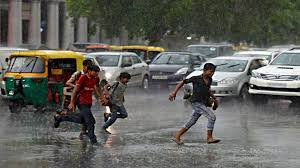By Aalekh July 1, 2025

As we step into July 2025, the monsoon is making its presence felt with renewed vigor across several parts of India. The Indian Meteorological Department (IMD) has predicted above-normal rainfall for this month, issuing yellow alerts for cities like Pune and Bengaluru—signaling the need for increased awareness and preparedness.
As we step into July 2025, the monsoon is making its presence felt with renewed vigor across several parts of India. The Indian Meteorological Department (IMD) has predicted above-normal rainfall for this month, issuing yellow alerts for cities like Pune and Bengaluru—signaling the need for increased awareness and preparedness.
Monsoon 2025: A Wetter Than Usual Outlook
July traditionally marks the peak of the monsoon season in India, but this year, forecasts indicate heavier-than-usual precipitation due to intensified monsoon activity. Meteorologists attribute this trend to active low-pressure systems over the Bay of Bengal and favorable westerly winds, pushing moist air deeper into the subcontinent.
According to IMD data, rainfall levels are likely to exceed seasonal averages, particularly in central and southern India. This increase may benefit water reservoirs and agricultural output, but also raises concerns around urban flooding, infrastructure stress, and travel disruptions.
Yellow Alert: What Does It Mean ?
A yellow alert is a moderate warning level issued by the IMD to prompt citizens and local authorities to “be aware.” It indicates that weather conditions may become severe, especially in low-lying or flood-prone areas. While not an immediate emergency, a yellow alert calls for:
Monitoring weather updates
Preparing for waterlogging in low-lying urban areas
Staying cautious while commuting, especially during peak rainfall hours
Ensuring children, elderly, and pets are safe indoors during downpours
City Spotlight: Pune and Bengaluru
Pune
Known for its relatively mild monsoon, Pune is bracing for unusually heavy showers this season. The city has already witnessed intermittent spells of rain in late June, and July is expected to bring more intense showers. The Pune Municipal Corporation (PMC) has activated emergency protocols to clear stormwater drains and prevent flash flooding.
Residents are advised to:
Avoid travel during heavy rainfall windows
Report clogged drains or water accumulation
Stay away from riverbanks and low-lying areas
Bengaluru’s monsoon is typically marked by sudden downpours and localized flooding. With the yellow alert in place, BBMP (Bruhat Bengaluru Mahanagara Palike) teams are working to clear debris from drains and lakes to prevent overflow incidents. Tech parks and residential complexes are also stepping up their flood preparedness.
Precautionary measures include:
Ensuring backup power systems are functional
Unplugging electronic devices during storms
Stocking up on essentials in case of mobility disruptions
Staying Safe During Heavy Rains
Whether you're living in the alert zones or just traveling through, here are some safety tips to keep in mind:
Use weather apps to track local forecasts and alerts
Avoid driving through waterlogged streets—they can hide open manholes or deep potholes
Keep emergency numbers handy, including disaster management, ambulance, and local police
Store dry food, water, and battery-powered lights in case of extended power cuts
Be Prepared, Not Panicked
While above-normal rainfall might cause temporary disruptions, it's also a vital contributor to water reserves and agricultural prosperity. The key lies in being proactive and prepared. Keep an eye on updates from the IMD, listen to local advisories, and most importantly, help your community stay safe and informed.
Your email address will not be published. Required fields are marked *